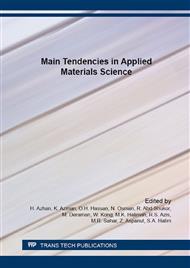[1]
B. O'Regan, M. Grätzel, A low-cost, high-efficiency solar cell based on dye-sensitized colloidal TiO2 films, Nature. 353 (1991) 737-740.
DOI: 10.1038/353737a0
Google Scholar
[2]
J. Liu, H. Yang, W. Tan, X. Zhou, Y. Lin, Photovoltaic performance improvement of dye-sensitized solar cells based on tantalum-doped TiO2 thin films, Electrochim. Acta, 56 (2010) 396-400.
DOI: 10.1016/j.electacta.2010.08.063
Google Scholar
[3]
S. Dueñas, H. Castán, H. García, E. S. Andrés, M. Toledano-Luque, I. Mártil, G. González-Díaz, K. Kukli, T. Uustare, J. Aarik, A comparative study of the electrical properties of TiO2 films grown by high-pressure reactive sputtering and atomic layer deposition, Semicond. Sci. Technol. 20 (2005).
DOI: 10.1088/0268-1242/20/10/011
Google Scholar
[4]
M. Thaidun, B. V. Rao, L. R. M. Reddy, G. V. Chalapathi, Structural, Dielectric and Optical properties of Sputtered TiO2, IOSR Journal of Applied Physics 4 (2013) 49-53.
DOI: 10.9790/4861-0424953
Google Scholar
[5]
I. C. Mirjana, M. D. Dramic, D. J. Jovanovic, S. P. Ahrenkiel, J. M. Nedeljkovic, Photoluminescence of Anatase and Rutile TiO2 Particles. J. Phys. Chem. B 110 (2006) 25366-25370.
Google Scholar
[6]
L. Chiodo, J. M. García-lastra, A. Iacomino, S. Ossicini, J. Zhao, H. Petek, A. Rubio, Self-Energy and Excitonic Effects in the Electronic and Optical Properties of TiO2 Crystalline Phases, J. Phys. Chem. B Phys. 82 (2010) 1-33.
DOI: 10.1103/physrevb.82.045207
Google Scholar
[7]
L. Chiodo, J. M. García-Lastra, D. J. Mowbray, A. Iacomino, A. Rubio, Tailoring electronic and optical properties of TiO2: nanostructuring, doping and molecular-oxide interactions, in: T. F. George, D. Jelski, R. R. Letfullin, G. Zhang, Computational Studies of New Materials II: From Ultrafast Processes and Nanostructures to Optoelectronics, Energy Storage and Nanomedicine, Ed. World Scientific, Hackensack, 2012, pp.301-330.
DOI: 10.1142/9789814287197_0012
Google Scholar
[8]
A. D. Paola, M. Bellardita, L. Palmisano, Brookite, the Least Known TiO2 Photocatalyst, 3 (2013) 36-73.
DOI: 10.3390/catal3010036
Google Scholar
[9]
N. Park, J. Lagemaat, A. J. Frank, Comparison of dye-sensitized rutile-and anatase-based TiO2 solar cells, J. Phys. Chem. B, 104 (2000) 8989-8994.
DOI: 10.1021/jp994365l
Google Scholar
[10]
M. F. M. Taib, M. K. Yaakob, F. W. Badrudin, T. I. T. Kudin, O. H. Hassan, M. Z. A. Yahya, First-Principles Calculation on the Structural, Elastic, Electronic and Lattice Dynamics of GeTiO3, Ferroelectrics. 452 (2013) 122-128.
DOI: 10.1080/00150193.2013.841525
Google Scholar
[11]
M. F. M. Taib, M. K. Yaakob, F. W. Badrudin, M. S. A. Rasiman, T. I. T. Kudin, O. H. Hassan, M. Z. A. Yahya, First-Principles Comparative Study of the Electronic and Optical Properties of Tetragonal (P4mm) ATiO3 (A=Pb, Sn, Ge), Integr. Ferroelectr. 155 (2014).
DOI: 10.1080/10584587.2014.905105
Google Scholar
[12]
M. Landmann, E. Rauls, W. G. Schmidt, The electronic structure and optical response of rutile, anatase and brookite TiO2, J. Phys. Condens. Matter. 24 (2012) 195503-19558.
DOI: 10.1088/0953-8984/24/19/195503
Google Scholar
[13]
D. M. Ceperley, B. J. Alder, Ground State of the Electron Gas by a Stochastic Method, Phys. Rev. Lett. 45 (1980) 566-569.
DOI: 10.1103/physrevlett.45.566
Google Scholar
[14]
J. P. Perdew , A. Zunger, Self-interaction correction to density-functional approximations for many-electron systems, Phys. Rev. B. 23 (1981) 5048-5079.
DOI: 10.1103/physrevb.23.5048
Google Scholar
[15]
S. J. Clark, M. D. Segall, C. J. Pickard, P. J. Hasnip, M. I. J. Probert, K. Refson, M. C. Payne, First principles methods using CASTEP, Zeitschrift für Kristallographie, 220 (2005) 567-570.
DOI: 10.1524/zkri.220.5.567.65075
Google Scholar
[16]
M. Horn, C. F. Schwerdtfeger, Refinement of the structure of anatase at several temperatures, Zeitschrift für Kristallographie, Bd. 136 (1972) 273-281.
DOI: 10.1524/zkri.1972.136.3-4.273
Google Scholar
[17]
R. W. G. Wyckoff, Crystal Structures, John Wiley, New York (1963).
Google Scholar
[18]
K. M. Reddya, S. Manoramaa, A. R. Reddy, Bandgap studies on anatase titanium dioxide nanoparticles, Mater. Chem. 78 (2003) 239-245.
Google Scholar
[19]
A. Amtout, R. Leonelli, Optical properties of rutile near its fundamental band gap, Phys. Rev. B, 51 (1995) 6842-6851.
DOI: 10.1103/physrevb.51.6842
Google Scholar
[20]
E. Sagvolden, J. Perdew, Discontinuity of the exchange-correlation potential: Support for assumptions used to find it, Phys. Rev. A, 77 (2008) 012517.
DOI: 10.1103/physreva.77.012517
Google Scholar
[21]
J. Lee, M. Yang, Progress in light harvesting and charge injection of dye-sensitized solar cells, Mater. Sci. Eng. B 176 (2011) 1142-1160.
DOI: 10.1016/j.mseb.2011.06.018
Google Scholar
[22]
S. Gong, B. Liu, Electronic structures and optical properties of TiO2: Improved density-functional-theory investigation, Chinese Phys. B 21 (2012).
Google Scholar
[23]
A. Kay, M. Grätzel, Low cost photovoltaic modules based on dye sensitized nanocrystalline titanium dioxide and carbon powder, 44 (1996) 99-117.
DOI: 10.1016/0927-0248(96)00063-3
Google Scholar
[24]
M. Baraton, Nano-TiO2 for Solar Cells and Photocatalytic Water Splitting: Scientific and Technological Challenges for Commercialization, Open Nanosci. J. (2011) 64-77.
DOI: 10.2174/1874140101105010064
Google Scholar
[25]
X. Zhang, F. Liu, Q. Huang, G. Zhou, Z. Wang, Dye-Sensitized W-Doped TiO2 Solar Cells with a Tunable Conduction Band and Suppressed Charge Recombination, J. Phys. Chem. C 115 (2011) 12665-12671.
DOI: 10.1021/jp201853c
Google Scholar
[26]
M. Wang, S. Bai, A. Chen, Y. Duan, Q. Liu, D. Li, Y. Lin, Improved photovoltaic performance of dye-sensitized solar cells by Sb-doped TiO2 photoanode, Electrochim. Acta. 77 (2012) 54-59.
DOI: 10.1016/j.electacta.2012.05.050
Google Scholar
[27]
R. Taziwa, E. Meyer, Carbon Doped Nano-Crystalline TiO2 Photo-Active Thin Film for Solid State Photochemical Solar Cells, Advances in Nanoparticles. 3 (2014) 54-63.
DOI: 10.4236/anp.2014.32008
Google Scholar
[28]
W. Li, J. Yang, J. Zhang, S. Gao, Y. Luo, M. Liu, Improve photovoltaic performance of titanium dioxide nanorods based dye-sensitized solar cells by Ca-doping, Mater. Res. Bull. 57 (2014) 177-183.
DOI: 10.1016/j.materresbull.2014.05.034
Google Scholar


